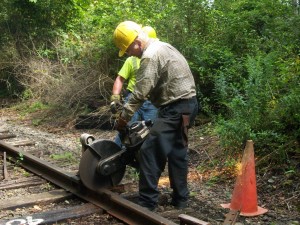The railways were once extremely dangerous places to work. In the 1850’s, a quarter of a million ‘navvies’ (a term derived from the word ‘navigators’ who built the first canals earlier in the same century), laid over 3,000 miles of railway lines in across the UK. These were tough men and women who travelled from job to job and lived and worked in dreadful conditions by today’s standards. According to the National Railway Museum, industrial pioneers such as Brunel, actively blocked efforts to allow workers access to safe living and working conditions, resulting in tremendous levels of illness, injury, and death . The construction of the Woodhead Tunnel, built in the middle of the 17-centutry, resulted in more deaths than the number of soldiers who died in the Battle of Waterloo.
Railway safety has improved considerably significantly, due in part to the use of technology (e.g. tunnel boring machines), modern construction techniques, and high standards of health and safety mandated by law. But even with today’s advances, rail workers are still killed or injured while building and maintaining our ageing railway network.
Electrocution of railway workers led to his death
An inquest at the end of March 2018 ruled that John Bell, a linesman working for Tyne and Wear Metro died accidentally. Mr Bell, who was 43, offered to undertake some repairs on a damaged ‘dropper’ (which connects two power cables) on the metro line on 6th July 2014. As he commenced the work in the proximity of the overhead cable, he was under the belief that the power had been isolated. On grabbing the cable with both hands, he was immediately electrocuted, which sent him falling from his ladder. He died at the scene as a result of the electrocution. On investigation, it was found that part of the power line had indeed been isolated, but not the one that Mr Bell was working on. The employer, Nexus, was fined £16,000 for breaching its obligations under the Health and Safety at Work etc Act 1974.
Rail workforce injuries and deaths down in the last ten years
Deaths of rail workers have been at their lowest for the past decade since 2015; no workers were killed in the year 2015/16 and one was killed in the following year – this contrasts with four in 2014/15. Injuries meanwhile have also trended down, from 8,497 in 2008 to 6,713 in 2016/17 – however these statistics relate to the mainline railways. Trams, metros, and other non-Network Rail networks (excluding the London Underground), have seen an increase from 68 injuries ten years ago to 308 in 2016/17 – a substantial increase . As such, the accident statistics paint a mixed picture, improvements on the wider Network Rail system, but more lapses on the other networks.
The leading causes of accidents to railway workers
According to official reporting to the Health and Safety Executive, under Reporting of Injuries, Diseases and Dangerous Occurrences Regulations 2013 (RIDDOR), the primary cause of accidents on the railways is slips, trips and falls ; a cause seen in so many other industries. The other causes are:
- Other injuries (20%) – including from machinery operation, platform-train
 interface issues, and shock or trauma from witnessing suicides.
interface issues, and shock or trauma from witnessing suicides. - Contact with an object (15%)
- On-board injuries (11%)
- Struck / crushed by train (7%)
- Platform-train interface (7%)
- Assault and abuse (7%)
The Rail Safety and Standards Board (RSSB) state the leading cause of fatalities to rail workers is being crushed by trains, which mainly affects infrastructure workers .
National Rail report that the zero rates of death and reduction of specified injuries are a result of their Home Safe Plan risk reduction programmes, which have the aim of ensuring that all workers return home after their shift.
In summary
The overall prevalence of accidents to workers on the railways has reduced significantly over the past few decades, with fatalities seeing the biggest overall reduction – from over 100 in the mid-1960’s to zero when compared to the last reporting year. However, the levels of safety are not as high on non-Network Rail networks – as in the case of Mr Bell.
If you have been injured while working on the railway network, whether in engineering, on-train staff, or any other role, you may be entitled to claim compensation for any pain and suffering you have endured, and any financial loss – including medical expenses, travel costs, and loss of earnings. Making a successful claim rests on being able to prove that your employer breached the required health and safety law that is supposed to ensure your safety while at work. If you are unsure if you have a valid case, contact one of our specialist workplace personal injury solicitors who will listen to the facts surrounding your accident, and advise if you can proceed with the claim process. If your employer was negligent in ensuring your safety, you are entitled and indeed, expected, to claim to help recover your health and financial costs.
At Russell Worth Solicitors we specialise in personal injury claims. If you have suffered a workplace injury and would like a free claim assessment, please call us now on 0800 028 2060 or complete our Online Claim Assessment.

